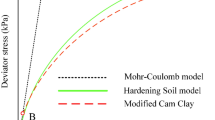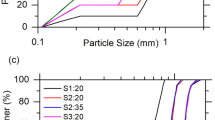Abstract
In order to study the safety factor and instability process of cohesive soil slope, the discrete element method(DEM) was applied. DEM software PFC2D was used to simulate the triaxial test to study the influence of the particle micro parameters on the macroscopic characteristics of cohesive soil and calibrate the micro parameters of DEM model on this basis. Embankment slope stability analysis was carried out by strength reduction and gravity increase method, it is shown that the safety factor obtained by strength reduction method is more conservative, and the arc-shaped feature of the sliding surface under the gravity increase method is more obvious. Throughout the progressive failure process, the failure trends, maximum displacements, and velocity changes obtained by the two methods were consistent. When slope was destroyed, the upper part was cracked, the middle part was sheared, and the lower part was destroyed by extrusion. The conclusions of this paper can be applied to the safety factor calculation of cohesive soil slopes and the analysis of the instability process.
摘要
为了研究黏性土边坡的安全系数和失稳过程,采用离散单元法(DEM),运用DEM 软件PFC2D 模拟三轴试验,研究颗粒微观参数对黏性土宏观特性的影响,并在此基础上对DEM 模型的微观参数 进行标定。采用强度折减法和重力增加法对路堤边坡稳定性进行了分析,结果表明,强度折减法得到 的安全系数较为保守,重力增加法下的滑动面弧形特征更加明显。在整个渐进破坏过程中,两种方法 得到的破坏趋势、最大位移和速度变化是一致的。边坡破坏时,上部开裂,中部剪切,下部挤压破坏。 本文的结论可应用于黏性土边坡的安全系数计算和失稳过程分析。
Similar content being viewed by others
References
LIU Guo-qiang, YANG Tao, LI Jing, JIA Yan-shun. Effects of aging on rheological properties of asphalt materials and asphalt-filler interaction ability [J]. Construction and Building Materials, 2018, 168: 501–511. DOI: https://doi.org/10.1016/j.conbuildmat.2018.02.171.
CHEN An-qi, LIU Guo-qiang, ZHAO Yong-li, LI Jing. Research on the aging and rejuvenation mechanisms of asphalt using atomic force microscopy [J]. Construction and Building Materials, 2018, 167(APR10): 177–184. DOI: https://doi.org/10.1016/j.conbuildmat.2018.02.008.
XIA Wei-yi, DU Yan-jun, LI Fa-sheng, Li Chun-ping, YAN Xiu-lan, ARULRAJAH A, WANG Fei, SONG De-jun. In-situ solidification/stabilization of heavy metals contaminated site soil using a dry jet mixing method and new hydroxyapatite based binder [J]. Journal of Hazardous Materials, 2019, 369: 353–361. DOI: https://doi.org/10.1016/jjhazmat.2019.02.031.
ALEJANO L R, FERRERO A M, RAMÍREZOYANGUREN P, FERNÁNDEZ M Á. Comparison of limit-equilibrium, numerical and physical models of wall slope stability [J]. International Journal of Rock Mechanics and Mining Sciences, 2011, 48(1): 16–26. DOI: https://doi.org/10.1016/j.ijrmms.2010.06.013.
ALEXAKIS H, MAKRIS N. Limit equilibrium analysis of masonry arches [J]. Archive of Applied Mechanics, 2015, 85(9, 10): 1363–1381. DOI:https://doi.org/10.1007/s00419-014-0963-6.
MICHALOWSKI R L. Stability assessment of slopes with cracks using limit analysis [J]. Canadian Geotechnical Journal, 2013, 50(10): 1011–1021. DOI: https://doi.org/10.1139/cgj-2012-0448.
CHEN Jun, ZHANG Dong, HUANG Xiao-ming. Application of discrete element particle flow software (PFC) in road engineering [M]. Beijing: China Communications Press Co., Ltd., 2015. (in Chinese)
MA Tao, ZHANG De-yu, ZHANG Yao, WANG Si-qi, HUANG Xiao-ming. Simulation of wheel tracking test for asphalt mixture using discrete element modelling [J]. Road Materials and Pavement Design, 2018, 19(2): 367–384. DOI: https://doi.org/10.1080/14680629.2016.1261725.
ZHOU Jian, JIA Ming-cai. Geotechnical meso-model test and numerical simulation [M]. Beijing: China Science Publishing & Media Ltd.,2008. (in Chinese)
MA Tao, WANG Hao, ZHANG De-yu, ZHANG Yao. Heterogeneity effect of mechanical property on creep behavior of asphalt mixture based on micromechanical modeling and virtual creep test [J]. Mechanics of Materials, 2017, 104: 49–59. DOI: https://doi.org/10.1016/j.mechmat.2016.10.003.
TANG Fan-long, MA Tao, ZHANG Jun-hui, GUAN Yong-sheng, CHEN Li-feng. Integrating three-dimensional road design and pavement structure analysis based on BIM [J]. Automation in Construction, 2020, 113(5): 103152. DOI: https://doi.org/10.1016/j.autcon.2020.103152.
ZHANG Yao, MA Tao, LING Meng, ZHANG De-yu, HUANG Xiao-ming. Predicting dynamic shear modulus of asphalt mastics using discretized-element simulation and reinforcement mechanisms [J]. Journal of Materials in Civil Engineering, 2019, 31(8): 04019163. DOI: https://doi.org/10.1061/(ASCE)MT.1943-5533.0002831.
WALTON O. Particle-dynamics calculations of shear flow [J]. Studies in Applied Mechanics, 1982, 7(1): 327–338. DOI: https://doi.org/10.1016/B978-0-444-42192-0.50033-5.
MA Tao, WANG Hao, HE Liang, ZHAO Yong-li, HUANG Xiao-ming, CHEN Jun. Property characterization of asphalt and mixtures modified by different crumb rubbers [J]. Journal of Materials in Civil Engineering, 2017, 29(7): 04017036–1–10. DOI: https://doi.org/10.1061/(ASCE)MT.1943-5533.0001890.
IWASHITA K, ODA M. Micro-deformation mechanism of shear banding process based on modified distinct element method [J]. Powder Technology, 2000, 2(1): 192–205. DOI: https://doi.org/10.2208/journalam.2.401.
ZHANG Yao, MA Tao, DING Xun-hao, HUANG Xiao-ming, XU Guang-ji. Impacts of air-void structures on the rutting tests of asphalt concrete based on discretized emulation [J]. Construction and Building Materials, 2018, 166: 334–344. DOI: https://doi.org/10.1016/j.conbuildmat.2018.01.141.
SHI Dan-da, XUE Jiang-feng, ZHAO Zhen-ying, SHI Ji-yu. A DEM investigation on simple shear behavior of dense granular assemblies [J]. Journal of Central South University, 2015, 22(12): 4844–4855. DOI: https://doi.org/10.1007/s11771-015-3036-2.
JIANG Ning-jun, DU Yan-jun, LIU Kai. Durability of lightweight alkali-activated ground granulated blast furnace slag (GGBS) stabilized clayey soils subjected to sulfate attack [J]. Applied Clay Science, 2018, 161: 70–75. DOI: https://doi.org/10.1016/j.clay.2018.04.014.
ZHANG Qiang, XU Wei-ya, LIU Qin-ya, WANG Wei, MENG Qing-xiang. A novel non-overlapping approach to accurately represent 2D arbitrary particles for DEM modelling [J]. Journal of Central South University, 2017, 24(1): 190–202. DOI: https://doi.org/10.1007/s11771-017-3420-1.
DING Xun-hao, MA Tao, GU Lin-hao, ZHANG De-yu, HUANG Xiao-ming. Discrete element methods for characterizing the elastic behavior of the granular particles [J]. Journal of Testing and Evaluation, 2020, 48: 20190178. DOI: https://doi.org/10.1520/JTE20190178.
TANG Fan-long, ZHU Shun-chao, XU Guang-ji, MA Tao, KONG Ling-di, KONG Ling-yun. Influence by chemical constitution of aggregates on demulsification speed of emulsified asphalt based on UV-spectral analysis [J]. Construction and Building Matierals, 2019, 212: 102–108. DOI: https://doi.org/10.1016/j.conbuildmat.2019.03.309.
DING Xun-hao, MA Tao, HUANG Xiao-ming. Discrete-element contour-filling modeling method for micromechanical and macromechanical analysis of aggregate skeleton of asphalt mixture [J]. Journal of Transportation Engineering, Part B: Pavements, 2019, 145(1): 04018056. DOI: https://doi.org/10.1061/JPEODX.0000083.
CAO Ri-hong, LIN Hang, CAO Ping. Strength and failure characteristics of brittle jointed rock-like specimens under uniaxial compression: Digital speckle technology and a particle mechanics approach [J]. International Journal of Mining Science and Technology, 2018, 28(4): 669–677. DOI: https://doi.org/10.1016/j.ijmst.2018.02.002.
CUNDALL P, STRACK O. Discussion: A discrete numerical model for granular assemblies [J]. Géotechnique, 1980, 30(3): 331–336. DOI: https://doi.org/10.1680/geot.1980.30.3.331.
WANG Cheng, TANNANT D, LILLY P. Numerical analysis of the stability of heavily jointed rock slopes using PFC2D [J]. International Journal of Rock Mechanics & Mining Sciences, 2003, 40(3): 415–424. DOI: https://doi.org/10.1016/S1365-1609(03)00004-2.
ZHOU Jian, WANG Jia-quan, ZENG Yuan, JIA Min-cai. Slope safety factor by methods of particle flow code strength reduction and gravity increase [J]. Rock and Soil Mechanics, 2009, 30(6): 1549–1554. DOI: https://doi.org/10.1016/S1874-8651(10)60073-7.
HE Chun-mei. Mechanical behavior of muddy soft rock and dynamic stability of soft-hard interbedded slopes in reservoir area under cyclic loading [D]. Chongqing: Chongqing University, 2018. (in Chinese)
FENG Xing-bo, SONG Dan-qing, XU Yong-fu. Simulation research on characteristics of embankment slope under rainfall scour [J]. Chinese Journal of Underground Space and Engineering, 2018, 14(2): 558–564. (in Chinese)
JIN Lei, ZENG Ya-wu, CHENG Tao, LI Jing-jing. Stability analysis of soil-rock mixture slope based on 3-D DEM [J]. Journal of Harbin Institute of Technology, 2020, 52(2): 41–50. DOI: https://doi.org/10.11918/201811110. (in Chinese)
BANERJEE A, PUPPALA A J, HOYOS L R. Suction-controlled multistage triaxial testing on clayey silty soil [J]. Engineering Geology, 2019, 265: 105409. DOI: https://doi.org/10.1016/j.enggeo.2019.105409.
SAIED M, YVES B, ABDELHAMID B, ULRICH M, BRIAN E. Creep deformation in vaca muerta shale from nanoindentation to triaxial experiments [J]. Journal of Geophysical Research: Solid Earth, 2019, 124(8): 7842–7868. DOI: https://doi.org/10.1029/2019JB017524.
XU Jian-bo, CHEN Jian-ping, JIANG Ping-jiang, CHENG Hu-jin. Investigation of creep behaviors of wudang mica schist by triaxial compression tests [J]. Geotechnical and Geological Engineering, 2019, 37(5): 3831–3842. DOI: https://doi.org/10.1007/s10706-019-00872-7 ISBN: 0960–3182.
MARTINELLI D, TODARO C, LUCIANI A, PEILA D. Use of a large triaxial cell for testing conditioned soil for EPBS tunnelling [J]. Tunnelling and Underground Space Technology, 2019, 94: 103126. DOI: https://doi.org/10.1016/j.tust.2019.103126.
BOL E, ÖNALP A, ÖZOCAK A, SERT S. Estimation of the undrained shear strength of Adapazari fine grained soils by cone penetration test [J]. Engineering Geology, 2019, 261, 105277. DOI: https://doi.org/10.1016/j.enggeo.2019.105277.
LIU Jian-kun, CUI Ying-hui, LIU Xin, CHANG Dan. Dynamic characteristics of warm frozen soil under direct shear test-comparison with dynamic triaxial test [J]. Soil Dynamics and Earthquake Engineering, 2020, 133: 106114. DOI: https://doi.org/10.1016/j.soildyn.2020.106114.
HE Zhong-ming, XIANG Da, LIU Ya-xin. Triaxial creep test and particle flow simulation of coarse-grained soil embankment filler [J]. Frontiers in Earth Science, 2020: 8. DOI: https://doi.org/10.3389/feart.2020.00062.
XIA Wei-yi, FENG Ya-song, DU Yan-jun, REDDY K R, WEI Ming-li. Stabilization and solidification of a heavy metal contaminated site soil using a hydroxyapatite based binder [J]. Construction and Building Materials, 2017, 156: 199–207. DOI: https://doi.org/10.1016/j.conbuildmat.2017.08.149.
CHEN Tian, LUAN Ying-cheng, MA Tao, ZHU Jun-qing, HUANG Xiao-ming, MA Si-jia. Mechanical and microstructural characteristics of different interfaces in cold recycled mixture containing cement and asphalt emulsion [J]. Journal of Cleaner Production, 2020, 258: 120674. DOI: https://doi.org/10.1016/j.jclepro.2020.120674.
KOCA T K, KOCA M Y. Comparative analyses of finite element and limit-equilibrium methods for heavily fractured rock slopes [J]. Journal of Earth System Science, 2020, 129: 65–76. DOI: https://doi.org/10.1007/s12040-019-1314-3.
DING Xun-hao, CHEN Lu-chuan, MA Tao, MA Hai-xia, GU Lin-hao, CHEN Tian, MA Yuan. Laboratory investigation of the recycled asphalt concrete with stable crumb rubber asphalt binder [J]. Construction and Building Materials, 2019, 203: 552–557. DOI: https://doi.org/10.1016/j.conbuildmat.2019.01.114.
WU Hao-liang, JIN Fei, BO Yu-lin. Leaching and microstructural properties of lead contaminated kaolin stabilized by GGBS-MgO in semi-dynamic leaching tests [J]. Construction and Building Materials, 2018, 172: 626–634. DOI: https://doi.org/10.1016/j.conbuildmat.2018.03.164.
TANG Fan-long, MA Tao, GUAN Yong-sheng, ZHANG Zhi-xin. Parametric modeling and structure verification of asphalt pavement based on BIM-ABAQUS [J]. Faculty of Engineering, 2020, 111: 103066. DOI: https://doi.org/10.1016/j.autcon.2019.103066.
MA Hui, CAI Jing-ming, LIN Zhan, QIAN Shun-zhi, LI V. CaCO3 whisker modified engineered cementitious composite with local ingredients [J]. Construction and Building Materials, 2017, 151: 1–8. DOI: https://doi.org/10.1016/j.conbuildmat.2017.06.057.
Author information
Authors and Affiliations
Corresponding author
Additional information
Foundation item: Project(51808116) supported by the National Natural Science Foundation of China; Project(BK20180404) supported by the Natural Science Foundation of Jiangsu Province, China; Project(KFJ170106) supported by the Changsha University of Science & Technology via Open Fund of National Engineering Laboratory of Highway Maintenance Technology, China; Project(242020R40133) supported by Fundamental Research Funds for the Central Universities, China
Rights and permissions
About this article
Cite this article
Xu, Gj., Zhong, Kz., Fan, Jw. et al. Stability analysis of cohesive soil embankment slope based on discrete element method. J. Cent. South Univ. 27, 1981–1991 (2020). https://doi.org/10.1007/s11771-020-4424-9
Received:
Accepted:
Published:
Issue Date:
DOI: https://doi.org/10.1007/s11771-020-4424-9




